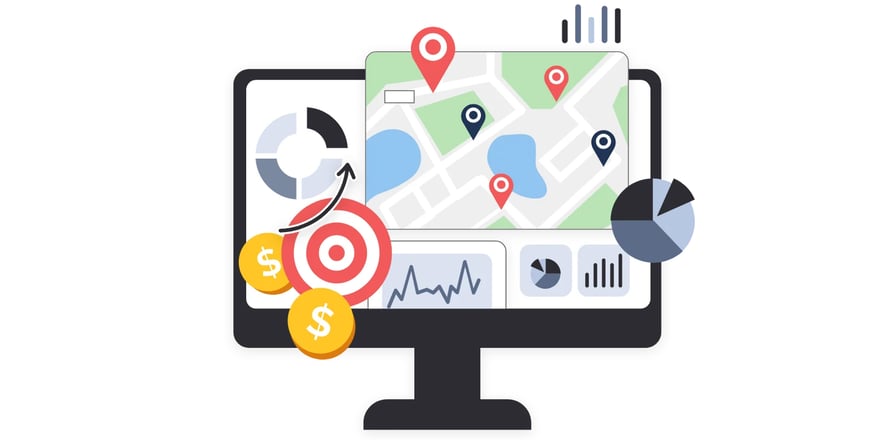Bullseye has been providing locator solutions for over 23 years. We’ve gained a lot of insight by witnessing some less than optimal implementations. We want to help you avoid these pitfalls. Here are 5 mistakes that we’d like to point out:
1. Perceiving your Locator as a Mere Convenience for Web Traffic
This is a big one, which can lead to countless other mistakes with your locator. If you think your locator exists solely as a convenience to direct web traffic to your dealers, you are probably throwing business away. This perception can cause companies to not get full potential out of their locator, because it undermines the understanding of how urgent the locator is. This can lead to not taking care of the details.
For companies who sell through dealers, the locator page is probably the 2nd most important page on the website (after the home page). After all, it is hard to overstate the importance of enabling customers to buy your product. If you shift your focus from your locator as a convenience to a critical tool to get sales, it will open a lot of doors.
Your locator has the potential to send customers to the right dealer. But getting them to the right dealer might not happen if you don’t make it easy for them. There is probably plenty of competition ready to sweep up your customers, and multiple ways for them to do so (Google, your competitor’s websites, HomeAdvisor, etc.). Once you understand the locator’s importance, it has the potential to trigger your own ideas that actually can make things much more convenient for your customers. You may start asking questions such as: “How can I see that my dealers are following up on Leads? Is my locator clearly displaying the capabilities of each dealer? Is it possible for me to make my locator visible outside of my website? Then, adjust your locator to implement the improvements.
Change your understanding of your locator as convenient to critical, and you’ll begin to reap the potential benefits.
2. Not Including your Locator as a Top Level Item in your Site’s Main Navigation
If your locator is tucked away in a menu somewhere, you are making your web traffic dig around before they buy your product. Believe it or not, we still see this approach often these days. If a potential customer wants to buy a product, it should be as easy as possible. Unless the company is purposefully de-emphasizing the locator (i.e. to sell direct), the locator should be very easy to spot.
As an additional tip, we recommend labeling the link to the locator with language that speaks to the audience and encourages buying. “Where to Buy” is probably better than “Dealer Locator” because it voices an action vs. passively communicating the software that the potential buyer will use.
3. Not Keeping your Locator Up to Date
This applies not only to keeping the dealer data current, but also keeping the locator software up to date.
Obviously it is important to keep the dealer data fresh, otherwise web traffic may be sent to stores that are closed, or they may get inaccurate contact information returned. In practice we recognize that sometimes it is easier said than done to keep the data up-to-date. We’ve come across many instances when companies have difficulty getting their data updated through their suppliers, distributors, etc. and the result is a locator with incomplete and inaccurate information.
If it is difficult to get the data, it may be worth considering purchasing the data from a data supplier.
Another item to consider is changing the locator software. Sometimes companies come to Bullseye to replace their locator, because they are running a locator that looks like it was designed 15 years ago. Most companies wouldn’t neglect their website design for that long, so why let the locator go for that long?
4. Being Stingy With Locator Content
If you provide a bare bones locator without engaging content, it gives potential customers a reason to abort their dealer search. If it is within your means to provide detailed information on your locator, we recommend displaying as much as possible. This may include, but is not limited to:
- Contact Information
- Phone Number
- Email address
- Photos
- Videos
- Business Hours
- Certifications
- Product Information
- Awards
Note that some of this information can be displayed on an SEO optimized local page, which gives your web traffic an opportunity to become familiar with your product and dealers before they make a purchase. The more they can learn, the better chance you have at making a sale.
5. Not Including Product Searches
A potential customer is much better off if they can search for dealers that carry your products vs. not have a product search. If you only provide an unfiltered dealer search, it puts the onus on the customer to do more research on their own. They may have to make several phone calls, or drive to multiple dealers to find what they are looking for, which is a recipe for an unhappy customer, or a lost customer.
Bullseye allows you to implement product searches, including nested filters if you have product families, or a complex product structure. You can include the products on the dealer’s record in the search results.




